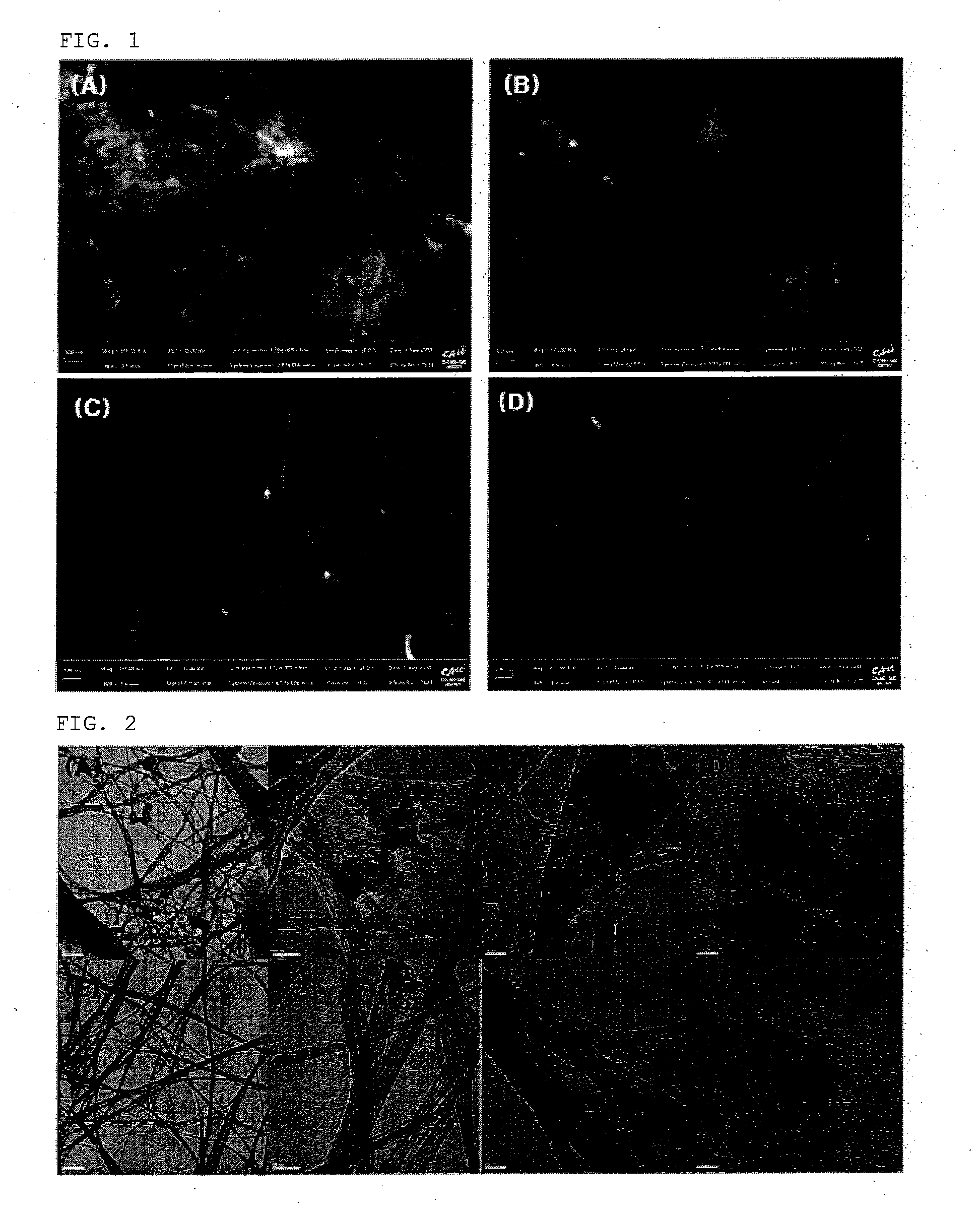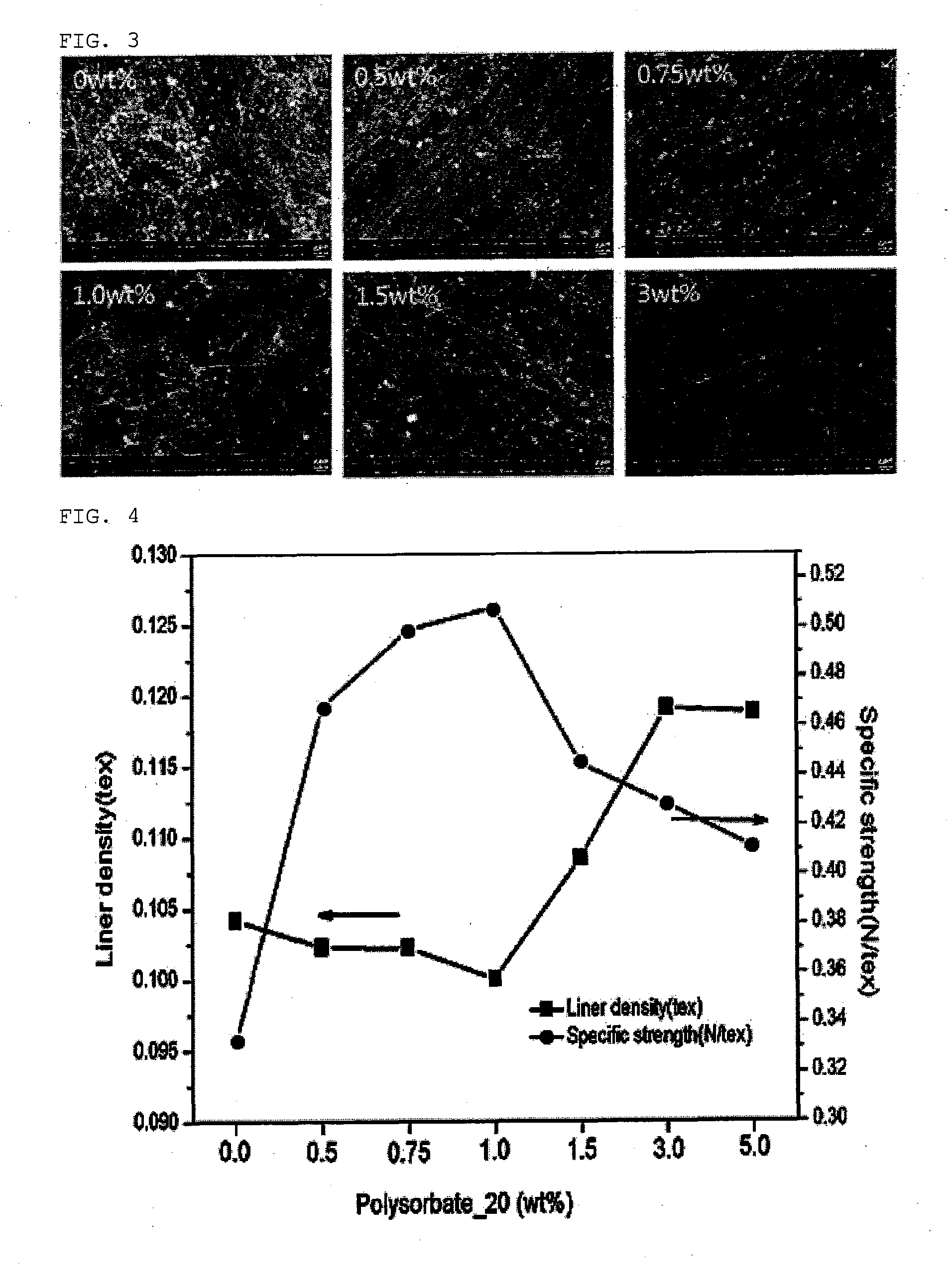Method for Preparing Carbon Nanotube Fibers with Improved Spinning Properties Using Surfactant
a technology surfactants, which is applied in the field of preparing carbon nanotube fibers with improved spinning properties, can solve the problems of affecting the strength and electrical properties affecting the agglomeration of particles, etc., and achieves the effect of improving the strength and conductivity of carbon nanotube fibers
- Summary
- Abstract
- Description
- Claims
- Application Information
AI Technical Summary
Benefits of technology
Problems solved by technology
Method used
Image
Examples
example 1
Preparation of Carbon Nanotube Fibers Using Carbon Nanotube Fiber Solution Containing Nonionic Surfactant (Polysorbate 20)
[0039]A mixed solution, prepared by adding 0.2 wt % ferrocene as a catalyst, 0.8 wt % thiophene as a promoter, and 1 wt % polysorbate 20 as a nonionic surfactant to the balance of acetone as a carbon source and dispersed by an ultrasonic device, and hydrogen gas were injected together into a vertical electric furnace at a rate of 10 ml / hour and 1 L / min, respectively, to synthesis carbon nanotubes fibers. At this time, the temperature of the electric furnace was 1,200° C. The synthesized carbon nanotubes fibers were passed through water at the bottom of the electric furnace to be spun into fibers and wound at a rate of 7.5 m / min.
example 2
Preparation of Carbon Nanotube Fibers with Improved Spinning Properties Using Nonionic Surfactant
[0040]A mixed solution, prepared by adding 1.5 wt % ferrocene as a catalyst, 0.1 wt % thiophene as a promoter, and 1 wt % polysorbate 20 as a nonionic surfactant to the balance of ethanol as a carbon source and dispersed by an ultrasonic device, and hydrogen gas were injected together into a vertical electric furnace at a rate of 5 ml / hour and 1.6 L / min, respectively, to synthesis carbon nanotubes fibers. At this time, the temperature of the electric furnace was 1,250° C. The synthesized carbon nanotubes fibers were wound at the bottom of the electric furnace and passed through water at the bottom of the electric furnace to be spun into fibers. The carbon nanotube fibers were immersed in a bath of 99.8% dimethyl sulfoxide (DMSO) to be densified, dried in a 200° C. dryer, and then wound at a rate of 9 m / min.
example 3
Preparation of Double-Walled Carbon Nanotube Fibers with Improved Spinning Properties Using Nonionic Surfactant
[0041]A mixed solution, prepared by adding 1 wt % ferrocene as a catalyst, 0.3 wt % thiophene as a promoter, and 1 wt % polysorbate 60 as a nonionic surfactant to the balance of ethanol as a carbon source and dispersed by an ultrasonic device, and hydrogen gas were injected together into a vertical electric furnace at a rate of 10 ml / hour and 1 L / min, respectively, to synthesis carbon nanotubes fibers. At this time, the temperature of the electric furnace was 1,200° C. The synthesized carbon nanotubes fibers were wound at the bottom of the electric furnace and passed through water at the bottom of the electric furnace to be spun into fibers. The carbon nanotube fibers were immersed in a bath of 99.8% dimethyl sulfoxide (DMSO) to be densified, dried in a 200° C. dryer, and then wound at a rate of 5 m / min.
PUM
| Property | Measurement | Unit |
|---|---|---|
| temperature | aaaaa | aaaaa |
| temperature | aaaaa | aaaaa |
| temperature | aaaaa | aaaaa |
Abstract
Description
Claims
Application Information
 Login to View More
Login to View More - R&D
- Intellectual Property
- Life Sciences
- Materials
- Tech Scout
- Unparalleled Data Quality
- Higher Quality Content
- 60% Fewer Hallucinations
Browse by: Latest US Patents, China's latest patents, Technical Efficacy Thesaurus, Application Domain, Technology Topic, Popular Technical Reports.
© 2025 PatSnap. All rights reserved.Legal|Privacy policy|Modern Slavery Act Transparency Statement|Sitemap|About US| Contact US: help@patsnap.com



